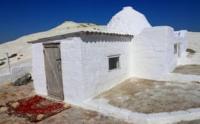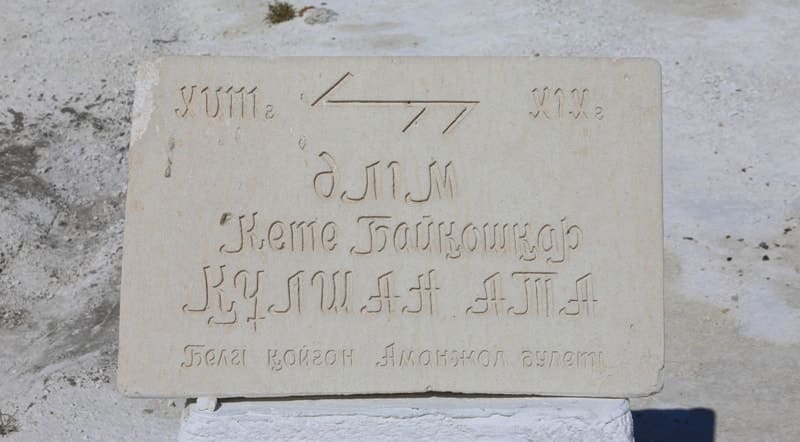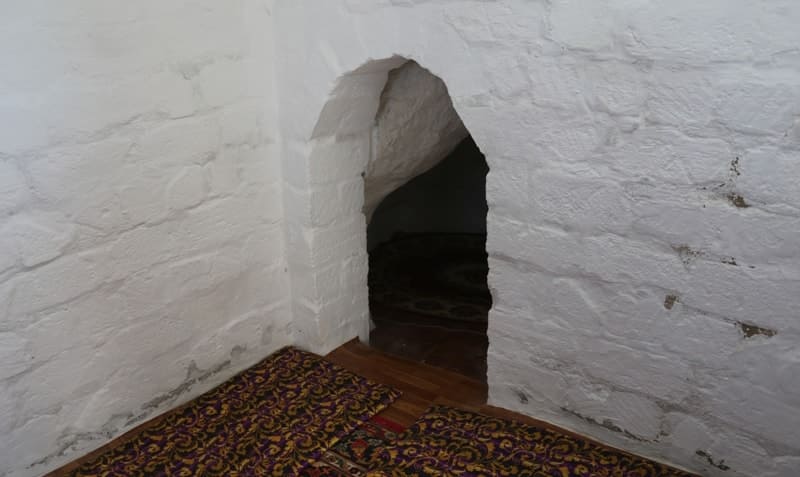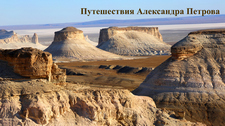Вы здесь
Kulshan Akmeshet.

Jeep tours Kazakhstan.
"On both sides of the room, right at the entrance to it, two filled-in pits are noticeable; according to the Kirghiz, these were digs with fresh water. On the right side there is a small room connected to the first door, near which there is a flat iron staff with a round and pointed iron end at the bottom. In the southwestern wall of the first room there is another door, leading into a round room, slightly larger in size than the first, and with a vault at the top, supported by a tetrahedral column, hollowed out in the middle. The walls of this room are not cut out in the form of a perfect circle, but with 6 symmetrically located depressions, of which one, located opposite the door, is somewhat wider and deeper than the others and is generally very similar to those made in Tatar mosques."
P.S. Savelyev. Russian archaeologist, orientalist-Arabist, numismatist, corresponding member of St. Petersburg Academy of Sciences. XIX century.
Adventure tours Kazakhstan.
Underground mosque Kulshan Akmosque is located at an altitude of 33 meters above sea level, is located 3.2 kilometers from left bank of Emba (Zhem) River, 6.7 kilometers to west and a little to south of underground mosque Akmechet Beket ata, 6.8 kilometers to west and a little south of Akmechet necropolis, 22.9 kilometers to east and a little to north of village of Akkiztogay, rural district of same name, 53.7 kilometers to northeast of city of Kulsary, in Zhylyoi district of Atyrau region.
According to legend, this mosque was built in the early XIXth century, Kulshan, a student of the talented religious educator, Islamic theologian, scientist and architect Beket ata. Akmechet Kulshan consists of two spacious rooms created from firmly laid chalk structures connected to each other by a three-layer arc.
The passage to the mosque is narrow, oblong, in the first room there is a special opening where the sun's rays always penetrate during the day, thus the mosque is illuminated by natural light. The walls have special recesses, in the depths of the south-eastern part of the room there is a mihrab.
Mihrab is a niche decorated with columns and an arch that indicates the direction of Mecca, it is intended for the imam to pray in it, thus during the prayer he is in front of the rest of the worshipers.
Here is what he writes about Akmechet-Beket and Akmechet-Kuldzhan Pavel Stepanovich Savelyev, Russian archaeologist, orientalist-Arabist, numismatist, corresponding member of St. Petersburg Academy of Sciences. XIX century:
"... Akmechet-Beket and Akmechet-Kuldzhan are located: the first is 38 miles below the Kandarala tract on the left mountain bank of the river. Emba, and the second on a small elevation 6 ½ from the first to the west and 3 ½ from Emba. Both graves have nothing remarkable on the surface and would have been very difficult to find if not for the large heaps of chalk lying above them, which did not attract the attention of the curious.
Examining the first more closely, we find in one place on the side of the river an opening similar to a large wolf hole, into which, however, a person, although with difficulty, can crawl. This opening extends into the depths of the earth no more than 3 sazhens, in a straight direction to the southwest.
And then leads into a round room, having a diameter of 2 ½ sazhens and up to 4 arshins high. Its ceiling is a flat dome, in the middle of which a narrow opening is drilled to the surface of the earth, letting in a weak light into the room. On both sides of the room, at the very entrance to it, two filled-in pits are noticeable; according to the Kirghiz, these were digs with fresh water.
On the right side there is a small room connected to the first door, near which there is a flat iron staff with a round and pointed iron end at the bottom. In the southwestern wall of the first room there is another door, leading into a round room, slightly larger in size than the first, and with a vault at the top, supported by a tetrahedral column, hollowed out in the middle.
The walls of this room are not cut out in the form of a perfect circle, but with 6 symmetrically located depressions, of which one, located opposite the door, is somewhat wider and deeper than the others and in general is very similar to those made in Tatar mosques.
There are no floors in the rooms; the walls are made roughly, but quite correctly. The soil in which this mosque is hollowed out consists of strong chalk. Above the mosque, on the surface of the earth, two or three small heaps of chalk are piled, probably over the bodies of dead Kirghiz.
Attached to the piles are several wooden poles, on which so many rags torn from clothes, horse hair and half-rotten bones are hung that, having seen and understood their meaning, one cannot help but be surprised at the religiosity of the semi-savages who left these insignificant signs of respect for the sanctity of the place."
Geographic coordinates of underground mosque Kulshan Akmechet: N47°07'57 E54°40'45




Authority:
http://culturemap.kz
Photos by:
Alexander Petrov.







